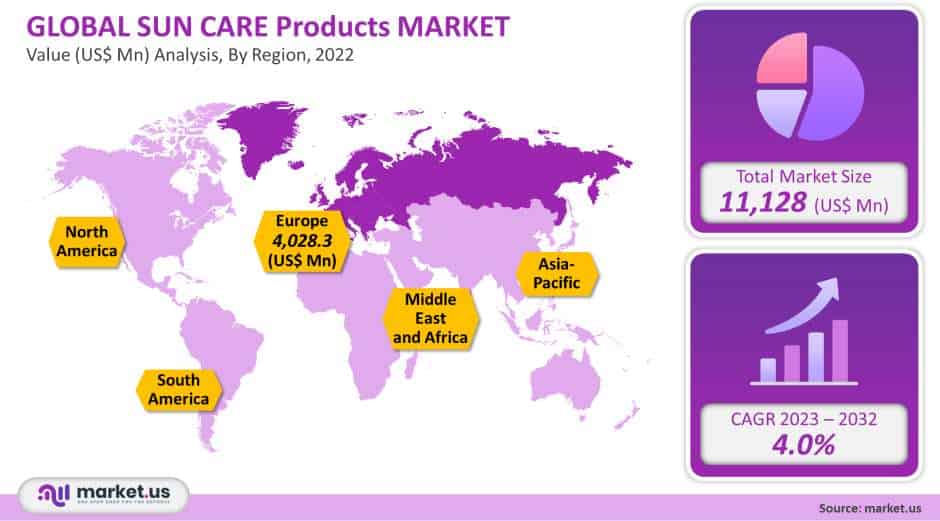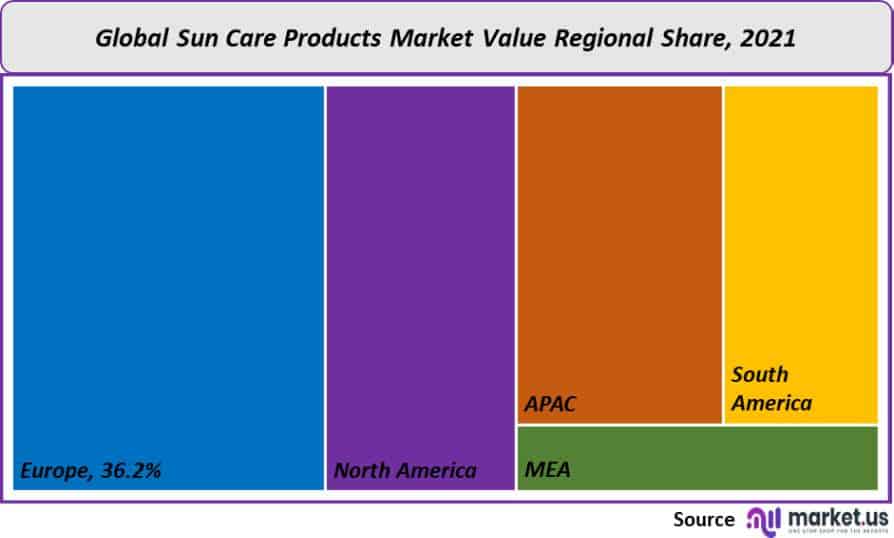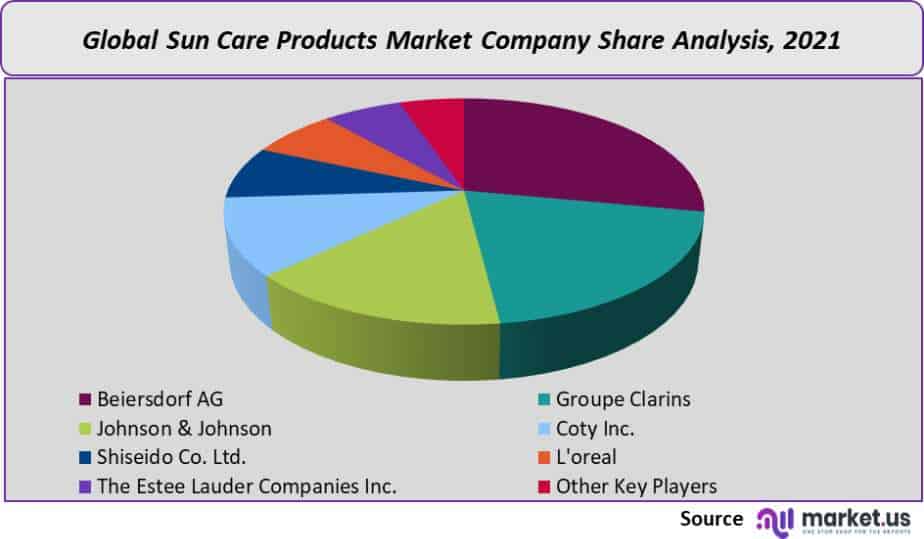Global Sun Care Products Market; By Product Type (Adult Sun Cream, Baby Sun Cream, After Sun, Fake Tan/Self Tan, and Tanning); By Application (Hypermarkets & Supermarkets, Pharmacy & Drug Stores, Specialty Stores, Online, and Other Distribution Channels); As well as by Region and Companies - Industry Segment Outlook, Market Assessment, Competition Scenario, Key Trends, and Forecast: 2023-2032
- Published date: March 2023
- Report ID: 17663
- Number of Pages: 384
- Format:
- keyboard_arrow_up
Quick Navigation
Report Overview
The global market for sun care products was valued at USD 11.1 billion in 2022 and is projected to grow at a CAGR of 4.0%, between 2023 and 2032. It is expected to reach USD 16.43 billion in the forecast period.
Major factors driving this market growth are growing concerns for protecting the skin from damaging sun rays, and an increased awareness concerning skin cancer.
Due to most individuals shifting to a work-at-home system, the COVID-19 pandemic has adversely impacted the sales of sun care products. This factor caused consumers to limit their travel around the globe for leisure, recreation, and sporting events in 2020. This, in turn, led to a reduction in consumer product consumption.

Global Sun Care Products Market Scope:
Product type analysis
In terms of ‘Product Type’, the ‘Adult Sun Cream’ segment dominated this market, accounting for over 70.4% of global revenues in 2021. It is expected that the segment will continue to dominate this industry over the forecast period.
Adult sun cream protects the skin from sunburns and premature aging effects like wrinkles and leathery skin. These creams are popular because of their multiple benefits including protection against high-risk skin cancer, skin discoloration, and inflammation.
There is a growing demand for organic and natural elements, which is expected to drive the growth of ‘After-Sun’ care products among adults. Adults are increasingly interested in products that contain mineral-based components like titanium dioxide or zinc oxide.
The ‘Fake Tan/Self-Tan’ segment is slated to be the fastest growing segment over the forecast, which will index a 5.2% CAGR, from 2023-2032. Sun-care products are registering an increase in demand due to the increasing popularity of sun-care products that can be used every day. Most sunless tanning products can be found in spray, cream, and lotion forms.
Distribution Channel Analysis
With respect to the ‘Distribution Channel’, the market’s largest segment, ‘Hypermarkets & Supermarkets’, accounted for over 49.2% of global revenues in 2021. This segment is expected to continue its dominance over the forecast period. These outlets are popular and usually located in the heart of a city, thus attracting a large number of customers. These stores offer a wide range of brands and are popular among consumers.
Supermarkets and hypermarkets offer a wide range of skin products for both men and women. These stores often have qualified staff to offer clients advice and assistance in the beauty aisles and cosmetics sections. Because of the increasing demand for cosmetics, and shrinking shelf spaces, it is easier for customers to choose from a broad range of products offered at these outlets.
However, the fastest CAGR (5.2%) is slated to be indexed by the ‘Specialty Stores’ segment, between 2023-2032. These specialty stores are able to offer a niche selection of products and they place great importance on customer service.
Specialty shops focus on specific products and have high customer satisfaction. To ensure a high quality of service, specialty shops offer a wide range of products. Several brands prefer to sell their products through specialty shops because these stores are more focused on well-known brands and provide exceptional service.
Кеу Маrkеt Ѕеgmеntѕ
By Product Type
- Adult Sun Creams
- Baby Sun Creams
- After Sun
- Fake Tan/Self Tan
- Tanning
By Application
- Hypermarkets & Supermarkets
- Pharmacy & Drug Stores
- Specialty Stores
- Online
- Other Distribution Channels
Market Dynamics:
The market for sun care products is expected to grow due to increasing health concerns and growing demand for natural, organic products. These products are typically derived from plants. They provide the skin with more benefits due to their natural ingredients.
Suncare products are expected to increase in popularity due to the growing awareness about skin diseases and skin cancers around the world. These products are also becoming more popular due to their multi-functional sun protection and wrinkle prevention properties.
As people become more aware of the importance of protecting their skin from UV rays, the global market for sun care products continues to grow rapidly. As governmental health agencies increase efforts to reduce the number of cases of UV-induced skin cancers, such products are steadily being used more frequently.
Regional Analysis
Europe was the dominant regional market, accounting for over 36.2% of global revenues in 2021. Consumer awareness concerning the negative effects of prolonged sun exposure has helped to increase product demand in this region. Products that provide additional benefits, such as anti-aging, dark spot reduction, and anti-aging benefits, are also increasing in demand.
The Asia Pacific is the fastest-growing regional market for sun care products and is expected to experience the highest CAGR between 2023 and 2032. The main driver of the Asia Pacific’s market growth is slated to be the expansion of the chemical industry in India and China.
Continuous access to raw materials for skin care product producers is likely to be a positive influence on this regional market over the forecast period. The Asia Pacific will be influenced by growing product demand from nations such as China and India, due to a higher number of product launches, as well as concerns about the harmful effects of ultraviolet rays.

Key Regions and Countries Covered іn This Rероrt:
- North America
- US
- Canada
- Mexico
- Europe
- Germany
- UK
- France
- Italy
- Russia
- Spain
- Rest of Europe
- APAC
- China
- Japan
- South Korea
- India
- Rest of Asia-Pacific
- South America
- Brazil
- Argentina
- Rest of South America
- MEA
- GCC
- South Africa
- Israel
- Rest of MEA
The sun care products market share is dominated by a handful of established players as well as medium-sized entities. One of the most important strategic initiatives in this industry is the launch of novel products.

Кеу Маrkеt Рlауеrѕ:
- Beiersdorf AG
- Groupe Clarins
- Johnson & Johnson
- Coty Inc.
- Shiseido Co. Ltd.
- L’oreal
- The Estee Lauder Companies Inc.
- Burt’s Bees
- Bioderma Laboratories
- Unilever
- Clarins Group
- Other Key Players
Frequently Asked Questions (FAQ)
Who are the major players in the sun care products market?Some major players operating in the sun care products market include Beiersdorf AG, Groupe Clarins, Johnson & Johnson Inc., Shiseido Co. Ltd., Coty Inc., L'oreal SAS, Beiersdorf AG, and The Estee Lauder Companies Inc.
What is the sun care products market growth?The global sun care products market size is expected to grow at a compound annual growth rate of 4.0% from 2021 to 2032 to reach USD 17.09 billion by 2032.
What is the current sun care products market value?The global sun care products market reached a valuation of USD 12.01 billion in 2023.
Which are the prominent regions in the sun care products market?The prominent regions in the sun care products market are North America, South Africa, Asia Pacific, Latin America, the Middle East & Africa, Saudi Arabia, South Korea, Central & South America, the United States, East Asia, and South Asia.
Which are the key market players in the sun care products market?The key market players in the sun care products market are Coty Inc., Johnson & Johnson, Shiseido Company, Bioderma Laboratories, L'Oreal S.A., Clarins Group, Revlon, Inc., Avon Products, Estee Lauder Co. Inc., Burt's Bees, and Proctor & Gamble.

- Beiersdorf AG
- Groupe Clarins
- Johnson & Johnson
- Coty Inc.
- Shiseido Co. Ltd.
- L'oreal
- The Estee Lauder Companies Inc.
- Burt's Bees
- Bioderma Laboratories
- Unilever Plc Company Profile
- Clarins Group
- Other Key Players
- settingsSettings
Our Clients
| Single User $4,599 $3,499 USD / per unit save 24% | Multi User $5,999 $4,299 USD / per unit save 28% | Corporate User $7,299 $4,999 USD / per unit save 32% | |
|---|---|---|---|
| e-Access | |||
| Report Library Access | |||
| Data Set (Excel) | |||
| Company Profile Library Access | |||
| Interactive Dashboard | |||
| Free Custumization | No | up to 10 hrs work | up to 30 hrs work |
| Accessibility | 1 User | 2-5 User | Unlimited |
| Analyst Support | up to 20 hrs | up to 40 hrs | up to 50 hrs |
| Benefit | Up to 20% off on next purchase | Up to 25% off on next purchase | Up to 30% off on next purchase |
| Buy Now ($ 3,499) | Buy Now ($ 4,299) | Buy Now ($ 4,999) |











